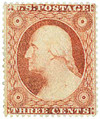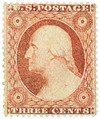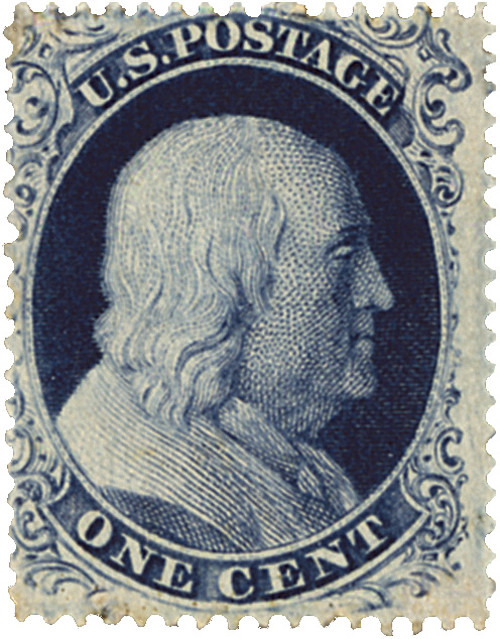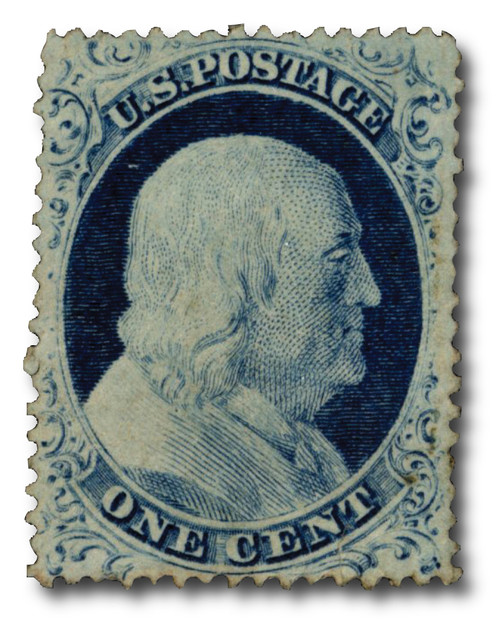
# 25 - 1857-61 3c Washington, type 1
U.S. #25
1857 Washington, Type I
- First Perforated Three-Cent U.S. Postage Stamp
Stamp Category: Definitive
Series: 1857-61 Issue
Value: 3c
Earliest documented use: February 28, 1857
Printed by: Toppan, Carpenter & Co.
Quantity printed: 38,750,000 (estimate)
Format: Printed in sheets of 200 stamps, divided into two panes of 100 each, in rows of 10x10
Printing Method: Engraved, Flat plate printing
Perforations: 15½
Color: Rose
Why the stamp was issued: The 3c Washington stamp was issued to pay the first-class rate for single letters of one-half ounce or less for a distance of up to 3,000 miles.
About the printing: The design is engraved on a die – a small, flat, polished piece of steel. The design is copied to a transfer roll – a blank roll of steel. Several impressions or “reliefs” are made on the roll. The reliefs are transferred to the plate – a large, flat piece of steel from which the stamps are printed.
Types or “varieties” occur when a stamp has differences which vary from the way it was originally engraved. A damaged plate or foreign matter can cause these differences on the plate and on the stamps printed from it. They can also occur when the design is being transferred to the plate when lines are manually re-cut. Lines re-cut on a worn plate can also result in double lines, called double transfers.
About the design: Recutting caused differences in the 3c Washington design’s frame lines, among other variations. This resulted in Types I, II, III, and IV. US #25 is Type I. An outer frame line is found on all four sides. #25 is nearly identical to the 3¢ imperforate stamp.
Special design details: George Washington’s portrait on the 3c stamp is based on a statue by French sculptor Jean-Antoine Houdon. The statue is considered by many to be one of the most life-like recreations of America’s first president. It was based on detailed measurements of his body as well as a life mask of his face. Washington’s statue is located in the rotunda of the Virginia state capitol building in Richmond, Virginia.
About the 1857-61 Series: The 1857-61 issues were the very first perforated U.S. stamps. Their designs were reproduced from the imperforate plates of 1851. Because the same plates were used, the perforated stamp types don’t differ much from the corresponding imperforate stamps. The entire series (U.S. #18-39) is noted for having narrow margins because it had to accommodate the perforations.
Recutting the plates was done in order to make room for the required number of stamps. With the recutting came variations in the degree of completeness or even lack of some design elements, like scrolls or frame lines. Sometimes newer plates were created to allow for more space between the stamps, making for further variations. All these differences make collecting even more fun and interesting as eager philatelists look to see what’s in their collection or what they want to add to it.
History the stamp represents: When the world’s first postage stamps were released, no provision was made for separating the stamps from one another. Post office clerks and stamp users merely cut these “imperforates” apart with scissors or tore them along the edge of a metal ruler. A device was needed which would separate the stamps more easily and accurately.
In 1847, Irishman Henry Archer patented a machine that punched holes horizontally and vertically between rows of stamps. Now stamps could be separated without cutting. Perforations enabled stamps to adhere better to envelopes. He sold his invention to the British Treasury in 1853. That same year, Great Britain produced its first perforated stamps.
The printing firm of Toppan, Carpenter & Co. reached out to Perkins, Bacon & Co, which had produced Britain’s perforated stamps. Perkins and Bacon were both Americans and Perkins was Charles Toppan’s uncle. They corresponded with Perkins and Bacon encouraging them to purchase a rouletting machine patented by the Bemrose brothers of England. Rouletting was unsuccessful, so George Howard converted it into a perforating machine in 1856. The following year, they used the machine to produce America’s first perforated postage stamps, the Series of 1857-61.
In the US, the Act of March 3, 1855, made the prepayment of postage mandatory as of that April, and the use of stamps for prepayment became mandatory on January 1, 1856. Postmaster General James A. Campbell predicted this change would greatly increase the demand for stamps. And it did – stamp use doubled over the course of the next two years.
U.S. #25
1857 Washington, Type I
- First Perforated Three-Cent U.S. Postage Stamp
Stamp Category: Definitive
Series: 1857-61 Issue
Value: 3c
Earliest documented use: February 28, 1857
Printed by: Toppan, Carpenter & Co.
Quantity printed: 38,750,000 (estimate)
Format: Printed in sheets of 200 stamps, divided into two panes of 100 each, in rows of 10x10
Printing Method: Engraved, Flat plate printing
Perforations: 15½
Color: Rose
Why the stamp was issued: The 3c Washington stamp was issued to pay the first-class rate for single letters of one-half ounce or less for a distance of up to 3,000 miles.
About the printing: The design is engraved on a die – a small, flat, polished piece of steel. The design is copied to a transfer roll – a blank roll of steel. Several impressions or “reliefs” are made on the roll. The reliefs are transferred to the plate – a large, flat piece of steel from which the stamps are printed.
Types or “varieties” occur when a stamp has differences which vary from the way it was originally engraved. A damaged plate or foreign matter can cause these differences on the plate and on the stamps printed from it. They can also occur when the design is being transferred to the plate when lines are manually re-cut. Lines re-cut on a worn plate can also result in double lines, called double transfers.
About the design: Recutting caused differences in the 3c Washington design’s frame lines, among other variations. This resulted in Types I, II, III, and IV. US #25 is Type I. An outer frame line is found on all four sides. #25 is nearly identical to the 3¢ imperforate stamp.
Special design details: George Washington’s portrait on the 3c stamp is based on a statue by French sculptor Jean-Antoine Houdon. The statue is considered by many to be one of the most life-like recreations of America’s first president. It was based on detailed measurements of his body as well as a life mask of his face. Washington’s statue is located in the rotunda of the Virginia state capitol building in Richmond, Virginia.
About the 1857-61 Series: The 1857-61 issues were the very first perforated U.S. stamps. Their designs were reproduced from the imperforate plates of 1851. Because the same plates were used, the perforated stamp types don’t differ much from the corresponding imperforate stamps. The entire series (U.S. #18-39) is noted for having narrow margins because it had to accommodate the perforations.
Recutting the plates was done in order to make room for the required number of stamps. With the recutting came variations in the degree of completeness or even lack of some design elements, like scrolls or frame lines. Sometimes newer plates were created to allow for more space between the stamps, making for further variations. All these differences make collecting even more fun and interesting as eager philatelists look to see what’s in their collection or what they want to add to it.
History the stamp represents: When the world’s first postage stamps were released, no provision was made for separating the stamps from one another. Post office clerks and stamp users merely cut these “imperforates” apart with scissors or tore them along the edge of a metal ruler. A device was needed which would separate the stamps more easily and accurately.
In 1847, Irishman Henry Archer patented a machine that punched holes horizontally and vertically between rows of stamps. Now stamps could be separated without cutting. Perforations enabled stamps to adhere better to envelopes. He sold his invention to the British Treasury in 1853. That same year, Great Britain produced its first perforated stamps.
The printing firm of Toppan, Carpenter & Co. reached out to Perkins, Bacon & Co, which had produced Britain’s perforated stamps. Perkins and Bacon were both Americans and Perkins was Charles Toppan’s uncle. They corresponded with Perkins and Bacon encouraging them to purchase a rouletting machine patented by the Bemrose brothers of England. Rouletting was unsuccessful, so George Howard converted it into a perforating machine in 1856. The following year, they used the machine to produce America’s first perforated postage stamps, the Series of 1857-61.
In the US, the Act of March 3, 1855, made the prepayment of postage mandatory as of that April, and the use of stamps for prepayment became mandatory on January 1, 1856. Postmaster General James A. Campbell predicted this change would greatly increase the demand for stamps. And it did – stamp use doubled over the course of the next two years.

















